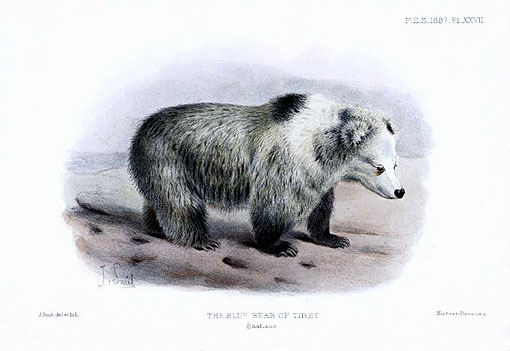|
| Query: himalayan blue bear | Result: 2nd of 5 | |
Tibetan Blue Bear (Ursus arctos pruinosus) - Wiki
| Subject: | Tibetan Blue Bear (Ursus arctos pruinosus) - Wiki
| |

| Resolution: 510x351
File Size: 69046 Bytes
Upload Date: 2007:08:20 16:14:25
|
Blue Bear
From Wikipedia, the free encyclopedia
[Photo] Tibetan Blue Bear (Ursus arctos pruinosus). Source http://www.classicnatureprints.com/pr.Smit%20Mammals/smith.blue.bear.html Date 1897. Author Joseph Smit (1836 - 1929) - Dutch zoological illustrator.
The Tibetan Blue Bear (Ursus arctos pruinosus) is a subspecies of the Brown Bear (Ursus arctos) found in the eastern Tibetan plateau. It is also known as the Himalayan Blue Bear, Himalayan Snow Bear, Tibetan Brown Bear, or the Horse Bear. In Tibetan it is known as Dom gyamuk. One of the rarest subspecies of bear in the world, the Blue Bear is rarely sighted in the wild, and is known in the west only through a small number of fur and bone samples. It was first classified in 1854.
The Blue Bear is notable for having been suggested as one possible inspiration for sightings associated with the legend of the yeti. A 1960 expedition to search for evidence of the yeti, lead by Sir Edmund Hillary, returned with two scraps of fur that had been identified by locals as 'yeti fur' that were later scientifically identified as being portions of the pelt of a Blue Bear. While it is unlikely that the Blue Bear generally occupies the high mountain peaks and snow fields where the yeti is generally considered to live, it is possible that the occasional specimen might be observed traveling through these regions during times of reduced food supply, or in search of a mate. However, the limited information available about the habits and range of the Blue Bear makes such speculation difficult to confirm.
The Gobi Brown Bear is sometimes classified as being of the same subspecies as the Tibetan Blue Bear; this is based on morphological similarities, and the belief that the desert-dwelling Gobi bear represents a relict population of the Blue Bear. However, the Gobi bear is sometimes classified as its own subspecies, and closely resembles other Asian brown bears.
The exact conservation status of the Blue Bear is unknown, due to limited information. However, in the United States trade in Blue Bear specimens or products is restricted by the Endangered Species Act. It is also listed in Appendix I of the Convention on International Trade in Endangered Species (CITES) as a protected species. It is threatened by the use of bear bile in traditional Chinese medicine and habitat encrochment.
http://en.wikipedia.org/wiki/Blue_Bear
| The text in this page is based on the copyrighted Wikipedia article shown in above URL. It is used under the GNU Free Documentation License. You may redistribute it, verbatim or modified, providing that you comply with the terms of the GFDL. |
|
Comments |
|---|
| | Val Franklin |
|
| This is very interesting - do you know why it is called 'blue'? Do you have any further information about its diet, habits, mating, cubs etc Please. I am writing an unusual book for children which is based in Tibet and will be describing some endangered animals there. I do not need to ujse the photo as an artist will be doing drawings. Thank you for your time. |
^o^
Animal Pictures Archive for smart phones
^o^
|
|
|